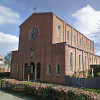Organ 29
The Opening Recital.
The opening recital was given by Neil Wright, the organist of Farnborough Abbey. He was asked because he is one of the foremost exponents of the French organ tradition.
The programme was:
War March of the Priests (from Athalie)
Felix Mendelssohn-Bartholdy (1809-1847)
Athalia was the daughter of Ahab and Jezebel (II Kings 11), and every bit as unpleasant as her mother. Jean Racine wrote a play about her life in 1691, and in 1845 Mendelssohn wrote incidental music for this play, as he had done for Shakespeare’s Midsummer Night’s Dream. In this year for priests, this is an excellent start to our recital.
Lied (Pièces en style libre Opus 31)
Arabesque (Pièces en style libre Opus 31)
Naïades (Pieces de Fantaisie Op55)
Louis Vierne (1870-1937)
Louis Vierne had poor eyesight all his life, bnd by the time he wrote his “24 pièces en Style Libre” he was practically blind. These 24 pieces, although published together, were written as pieces for the Offertory at Mass. “Naïades” was not written as a liturgical piece; the title refers to nymphs in Greeg mythology who have a responsibility for running water.
Offertoire l’Éclatante
Michel Corrette (1709-1795)
Corrette was born in Rouen, Normandy. His father, Gaspard Corrette, was an organist and composer. Corrette served as organist at the Jesuit College in Paris from about 1737 to 1780. L’Eclatante comes from his 3rd organ book of 1756.
Basse et Dessus de Trompette (from Suite du Premier Ton)
Louis-Nicolas Clérambault (1676-1749)
French composer and organist. He studied music with André Raison and Jean-Baptiste Moreau, and around 1705 he was appointed surintendant for Louis XIV. Around 1710 he became the organist at St Sulpice in Paris — this before the building was completed, and well before the 1862 famous Cavaillé-Coll organ. This piece probably dates from his time there.
We are familiar with two modes; major and minor keys. Gregorian plainchant has 8 tones. Tone 1 can be thought of as an eight note scale running from Re to Re (as opposed to Doh to Doh). This is also known as the Dorian Mode.
Pièce d’Orgue BWV572
J.S.Bach (1685-1750)
Also known as the Fantasy in G major, this piece was written before 1712; a relatively early work in Bach’s long career. The composer entitled its sections in French, the first section Vivement, the second Gravement. The final section is entitled Lentement. Bach has been the acknowledged master of organ composition, and the 19th century French organ school held him is high esteem
Choral Dorien (Deux Chorals)
Jehan Alain (1911-1940)
Alain was an early fatality of the Second World War, but he left behind an important body of music. The Choral Dorien speaks of his deep faith in God: on the last page of his diary before he died he had written: “I believe in God and in Christ”
Cantabile (from Trois Pièces)
César Franck (1822-1890)
Franck was regarded by many as the 19th century answer to Bach, and his Trois Pieces was one of the works that helped him to gain that high reputation. Written for the opening of the Trocadero organ in 1878, and not for liturgical use, yet it embodies the deep spirituality of the composer. The original Trocadero (now demolished) was Paris’ Albert Hall.
Marche en Ré majeur Op56/3
Alexandre Guilmant (1837-1911)
Composed in 1882, Guilmant was both organist at the Trinity Church in Paris, and regularly performed at the Trocadero.
Improvisation on a submitted theme
Neil Wright
The theme was from the Harry Potter films, Hedwig’s Theme. The piece was recieved with acclaim, and Neil was given a standing ovation.
